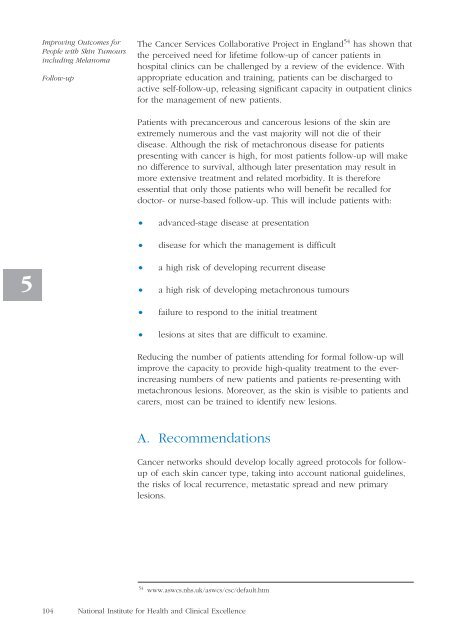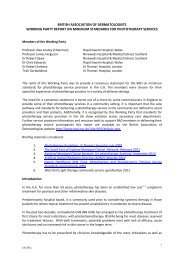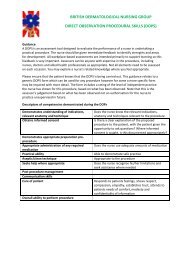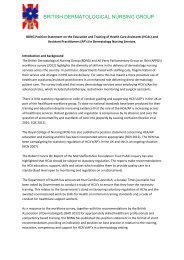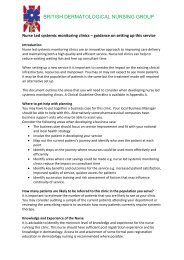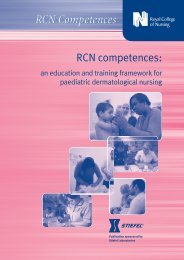Improving outcomes for people with skin tumours including melanoma
Improving outcomes for people with skin tumours including melanoma
Improving outcomes for people with skin tumours including melanoma
You also want an ePaper? Increase the reach of your titles
YUMPU automatically turns print PDFs into web optimized ePapers that Google loves.
<strong>Improving</strong> Outcomes <strong>for</strong><br />
People <strong>with</strong> Skin Tumours<br />
<strong>including</strong> Melanoma<br />
Follow-up<br />
The Cancer Services Collaborative Project in England 54 has shown that<br />
the perceived need <strong>for</strong> lifetime follow-up of cancer patients in<br />
hospital clinics can be challenged by a review of the evidence. With<br />
appropriate education and training, patients can be discharged to<br />
active self-follow-up, releasing significant capacity in outpatient clinics<br />
<strong>for</strong> the management of new patients.<br />
Patients <strong>with</strong> precancerous and cancerous lesions of the <strong>skin</strong> are<br />
extremely numerous and the vast majority will not die of their<br />
disease. Although the risk of metachronous disease <strong>for</strong> patients<br />
presenting <strong>with</strong> cancer is high, <strong>for</strong> most patients follow-up will make<br />
no difference to survival, although later presentation may result in<br />
more extensive treatment and related morbidity. It is there<strong>for</strong>e<br />
essential that only those patients who will benefit be recalled <strong>for</strong><br />
doctor- or nurse-based follow-up. This will include patients <strong>with</strong>:<br />
• advanced-stage disease at presentation<br />
• disease <strong>for</strong> which the management is difficult<br />
5<br />
• a high risk of developing recurrent disease<br />
• a high risk of developing metachronous <strong>tumours</strong><br />
• failure to respond to the initial treatment<br />
• lesions at sites that are difficult to examine.<br />
Reducing the number of patients attending <strong>for</strong> <strong>for</strong>mal follow-up will<br />
improve the capacity to provide high-quality treatment to the everincreasing<br />
numbers of new patients and patients re-presenting <strong>with</strong><br />
metachronous lesions. Moreover, as the <strong>skin</strong> is visible to patients and<br />
carers, most can be trained to identify new lesions.<br />
A. Recommendations<br />
Cancer networks should develop locally agreed protocols <strong>for</strong> followup<br />
of each <strong>skin</strong> cancer type, taking into account national guidelines,<br />
the risks of local recurrence, metastatic spread and new primary<br />
lesions.<br />
54 www.aswcs.nhs.uk/aswcs/csc/default.htm<br />
104<br />
National Institute <strong>for</strong> Health and Clinical Excellence


